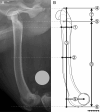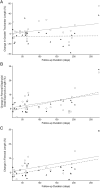Evaluation of the effects of cementless total hip replacement on femoral length in skeletally immature dogs
- PMID: 39465892
- PMCID: PMC11734876
- DOI: 10.1111/vsu.14180
Evaluation of the effects of cementless total hip replacement on femoral length in skeletally immature dogs
Abstract
Objective: To describe percentage length changes in the femur after total hip replacement (THR) performed before skeletal maturity.
Study design: Retrospective study.
Animals: Twenty-four dogs younger than 8.5 months which underwent unilateral THR and had radiographic follow up.
Methods: Preoperative and follow-up radiographs were reviewed. Radiographic measurements included the length of the greater trochanter, femoral diaphysis and distal epiphysis, width of the femur 10 mm distal to the distal aspect of the greater trochanter, width of the femur at 50%, and femoral condylar offset. Percentage changes in length over time were compared among operated and contralateral femurs used as controls. Measurements were collected in triplicate in 10 dogs to evaluate consistency.
Results: All repeated measurements had excellent consistency. The percentage increase in length of the greater trochanter was smaller in operated femurs than controls (mean difference: -11.5%, p = .017), but no differences were observed for the femoral diaphysis and distal epiphysis (-1.0%, p = .595), or the femur overall (-2.3%, p = .232). The percentage increase in femoral cortical width was greater in operated femurs than controls, both 10 mm distal to the greater trochanter (4.6% difference, p = .037) and at 50% length (8.5% difference, p = .030).
Conclusion: In growing dogs, cementless THR decreased trochanteric growth by approximately 10% but did not change diaphyseal growth and femoral growth.
Clinical significance: Cementless THR performed in skeletally immature dogs with severe hip problems did not impact femoral length in a clinically relevant fashion.
© 2024 The Author(s). Veterinary Surgery published by Wiley Periodicals LLC on behalf of American College of Veterinary Surgeons.
Conflict of interest statement
Vezzoni L and Marcellin‐Little DJ are remunerated members of Movora's Global Advisory Board and Vezzoni A is a nonremunerated honorary member of Movora's Global Advisory Board. Movora is the manufacturer and distributor of the total hip replacement implants used in the study. The other authors have no financial or personal relationships that could inappropriately influence or bias the study content.
Figures



Similar articles
-
Greater trochanter morphology and association with patient demographics, surgical factors, and post-operative stem position: a retrospective assessment of 150 cementless THRs in 135 dogs.BMC Vet Res. 2022 Feb 23;18(1):78. doi: 10.1186/s12917-022-03174-y. BMC Vet Res. 2022. PMID: 35197062 Free PMC article.
-
Outcome of canine cementless collared stem total hip replacement with proximal femoral periprosthetic cerclage application: 184 consecutive cases.Vet Surg. 2022 Feb;51(2):270-278. doi: 10.1111/vsu.13740. Epub 2021 Oct 16. Vet Surg. 2022. PMID: 34655241
-
Does Femoral Morphology Predict the Risk of Periprosthetic Fracture After Cementless Total Hip Arthroplasty?J Arthroplasty. 2020 Jun;35(6S):S359-S363. doi: 10.1016/j.arth.2020.02.048. Epub 2020 Feb 29. J Arthroplasty. 2020. PMID: 32209287
-
Femur fractures associated with canine total hip replacement.Vet Surg. 2004 Mar-Apr;33(2):164-72. doi: 10.1111/j.1532-950X.2004.04024.x. Vet Surg. 2004. PMID: 15027978
-
Femoral offset: anatomical concept, definition, assessment, implications for preoperative templating and hip arthroplasty.Orthop Traumatol Surg Res. 2009 May;95(3):210-9. doi: 10.1016/j.otsr.2009.03.010. Epub 2009 May 6. Orthop Traumatol Surg Res. 2009. PMID: 19423418 Review.
References
-
- Alexander JW. The pathogenesis of canine hip dysplasia. Vet Clin North Am Small Anim Pract. 1992;22:503‐511. - PubMed
-
- Budsberg SC, Chambers JN, Lue SL, et al. Prospective evaluation of ground reaction forces in dogs undergoing unilateral total hip replacement. Am J Vet Res. 1996;57:1781‐1785. - PubMed
-
- Lascelles BD, Freire M, Roe SC, et al. Evaluation of functional outcome after BFX total hip replacement using a pressure sensitive walkway. Vet Surg. 2010;39:71‐77. - PubMed
-
- Marcellin‐Little DJ, DeYoung BA, Doyens DH, et al. Canine uncemented porous‐coated anatomic total hip arthroplasty: results of a long‐term prospective evaluation of 50 consecutive cases. Vet Surg. 1999;28:10‐20. - PubMed
-
- Guerrero TG, Montavon PM. Zurich cementless total hip replacement: retrospective evaluation of 2nd generation implants in 60 dogs. Vet Surg. 2009;38:70‐80. - PubMed

